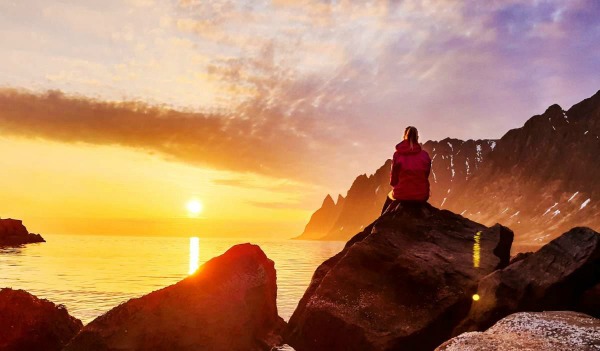By Lisa Taylor
Our lives are structured around daily routines. We tend to wake up at similar times each work day. Research has shown that, although individual routines may vary, people tend to have five specific activities that they do in the same order, each day, shortly after waking. But how do we stick to our routines if there’s no sunset or sunrise?
On a recent trip to Norway, I travelled to Sommarøy, a small fishing village of 350 residents on the western shore of Norway’s north coast. In the summer, Sommarøy experiences a midnight sun; it doesn’t set for 100 days. It also creeps through the polar night in winter, with 60 days of complete darkness.

At the beginning of the midnight sun, residents from this village take off their watches and leave them attached to the bridge that provides access into the main part of town. They will tell any and all visitors that they do this to mark the beginning of 100 days of no darkness and no time.


Residents of Sommarøy fish and tend to the land. Our host explained that, with no darkness, he can fish or tend to his property at any time of day or night. It makes no difference if it is 3:00 PM or 3:00 AM. “We sleep when we are tired,” he explained, relying only on internal cues of how he is feeling to separate time for work and time for rest.
It is a challenging concept and, after having experienced the midnight sun for just one week, I can understand why many Norwegians report finding it more difficult to get used to than the polar night. Researchers at the Arctic University of Norway have been studying why the incidence of Seasonal Affective Disorder (SAD) in nearby Tromsø remains lower than many other European and North American cities where the sun rises and sets each day.
Early findings suggest that the Norwegian ability to adapt to the periods of light and darkness can be tied to mindset. Initially setting out to study the challenges people faced during polar night, the lead researcher quickly realized that her initial perspective and hypothesis was biased. Tools measuring SAD incidence rates and severity assumed that darker days were by default problematic. But, early interviews uncovered that many residents preferred the winter dark season. It wasn’t seen as an issue or something to endure. Instead, the polar night provided more significant close family time and vibrant social life spent visiting in friends’ home. With weeks of pure darkness, the concept of making time suit one’s schedule still holds, but how the time is spent is very different than in the midnight sun, where people stroll the streets and visit pubs well into the wee hours of the morning. It seems attending sun-drenched celebrations offer less reward than preparing a comforting dish and sharing it among friends in homes.
Without strong discipline and being attuned to one’s own internal cues, the midnight sun can be exhausting. It is easy for time to slip by without realizing just how much you need to recharge. When you can’t rely on others around you or even the sun to remind you of day’s end, you can easily slip into endless days. So too, the polar night requires equal discipline: to remember not to hibernate but to seek opportunities to gather in intimate settings and spend time tending to meaningful relationships.
The midnight sun and polar night are powerful metaphors for our work. Often, when our work is going well and we are achieving our goals, we are driven to work harder and longer. We may miss personal cues that we need rest, or we may find ways to suppress the cues extending our working day well beyond what is sustainable. While the midnight sun does eventually set, on a schedule that is known and predictable, in our work we often don’t know when good times might end and so we seek to “make hay while the sun is shining.” We seek to take advantage of every last hour, minute, and second without heeding warnings that we are tiring or pushing beyond our natural limits.


In darker times, when everything is a struggle and the way forward is not always easy to see, we have the tendency to try to make it through alone. Collaborating or confiding in others takes more energy and effort and, so, in a period that is already difficult, we may hunker down and wait for lighter times. We might ignore what we already know—that humans are social beings and our personal relationships can see us through challenging professional times.
Through light and dark, we need to remember how the residents of Sommarøy approach work and time. We need to pay just as much attention to what’s happening within us as we do to the world around us. It is the only way we’ll know to rest when we are tired and to remember to band together when we are challenged. With this awareness comes an ability to appreciate both the light and the dark. To see value in what is created, nurtured, and accomplished across a much longer time horizon than a single season. To provide strength, satisfaction, and accomplishment across many cycles.

